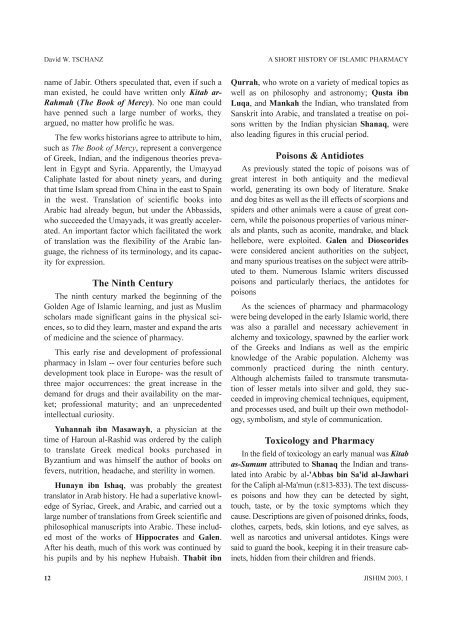A Short History of Islamic Pharmacy - International Society for the ...
A Short History of Islamic Pharmacy - International Society for the ...
A Short History of Islamic Pharmacy - International Society for the ...
You also want an ePaper? Increase the reach of your titles
YUMPU automatically turns print PDFs into web optimized ePapers that Google loves.
David W. TSCHANZ<br />
A SHORT HISTORY OF ISLAMIC PHARMACY<br />
name <strong>of</strong> Jabir. O<strong>the</strong>rs speculated that, even if such a<br />
man existed, he could have written only Kitab ar-<br />
Rahmah (The Book <strong>of</strong> Mercy). No one man could<br />
have penned such a large number <strong>of</strong> works, <strong>the</strong>y<br />
argued, no matter how prolific he was.<br />
The few works historians agree to attribute to him,<br />
such as The Book <strong>of</strong> Mercy, represent a convergence<br />
<strong>of</strong> Greek, Indian, and <strong>the</strong> indigenous <strong>the</strong>ories prevalent<br />
in Egypt and Syria. Apparently, <strong>the</strong> Umayyad<br />
Caliphate lasted <strong>for</strong> about ninety years, and during<br />
that time Islam spread from China in <strong>the</strong> east to Spain<br />
in <strong>the</strong> west. Translation <strong>of</strong> scientific books into<br />
Arabic had already begun, but under <strong>the</strong> Abbassids,<br />
who succeeded <strong>the</strong> Umayyads, it was greatly accelerated.<br />
An important factor which facilitated <strong>the</strong> work<br />
<strong>of</strong> translation was <strong>the</strong> flexibility <strong>of</strong> <strong>the</strong> Arabic language,<br />
<strong>the</strong> richness <strong>of</strong> its terminology, and its capacity<br />
<strong>for</strong> expression.<br />
The Ninth Century<br />
The ninth century marked <strong>the</strong> beginning <strong>of</strong> <strong>the</strong><br />
Golden Age <strong>of</strong> <strong>Islamic</strong> learning, and just as Muslim<br />
scholars made significant gains in <strong>the</strong> physical sciences,<br />
so to did <strong>the</strong>y learn, master and expand <strong>the</strong> arts<br />
<strong>of</strong> medicine and <strong>the</strong> science <strong>of</strong> pharmacy.<br />
This early rise and development <strong>of</strong> pr<strong>of</strong>essional<br />
pharmacy in Islam -- over four centuries be<strong>for</strong>e such<br />
development took place in Europe- was <strong>the</strong> result <strong>of</strong><br />
three major occurrences: <strong>the</strong> great increase in <strong>the</strong><br />
demand <strong>for</strong> drugs and <strong>the</strong>ir availability on <strong>the</strong> market;<br />
pr<strong>of</strong>essional maturity; and an unprecedented<br />
intellectual curiosity.<br />
Yuhannah ibn Masawayh, a physician at <strong>the</strong><br />
time <strong>of</strong> Haroun al-Rashid was ordered by <strong>the</strong> caliph<br />
to translate Greek medical books purchased in<br />
Byzantium and was himself <strong>the</strong> author <strong>of</strong> books on<br />
fevers, nutrition, headache, and sterility in women.<br />
Hunayn ibn Ishaq, was probably <strong>the</strong> greatest<br />
translator in Arab history. He had a superlative knowledge<br />
<strong>of</strong> Syriac, Greek, and Arabic, and carried out a<br />
large number <strong>of</strong> translations from Greek scientific and<br />
philosophical manuscripts into Arabic. These included<br />
most <strong>of</strong> <strong>the</strong> works <strong>of</strong> Hippocrates and Galen.<br />
After his death, much <strong>of</strong> this work was continued by<br />
his pupils and by his nephew Hubaish. Thabit ibn<br />
Qurrah, who wrote on a variety <strong>of</strong> medical topics as<br />
well as on philosophy and astronomy; Qusta ibn<br />
Luqa, and Mankah <strong>the</strong> Indian, who translated from<br />
Sanskrit into Arabic, and translated a treatise on poisons<br />
written by <strong>the</strong> Indian physician Shanaq, were<br />
also leading figures in this crucial period.<br />
Poisons & Antidiotes<br />
As previously stated <strong>the</strong> topic <strong>of</strong> poisons was <strong>of</strong><br />
great interest in both antiquity and <strong>the</strong> medieval<br />
world, generating its own body <strong>of</strong> literature. Snake<br />
and dog bites as well as <strong>the</strong> ill effects <strong>of</strong> scorpions and<br />
spiders and o<strong>the</strong>r animals were a cause <strong>of</strong> great concern,<br />
while <strong>the</strong> poisonous properties <strong>of</strong> various minerals<br />
and plants, such as aconite, mandrake, and black<br />
hellebore, were exploited. Galen and Dioscorides<br />
were considered ancient authorities on <strong>the</strong> subject,<br />
and many spurious treatises on <strong>the</strong> subject were attributed<br />
to <strong>the</strong>m. Numerous <strong>Islamic</strong> writers discussed<br />
poisons and particularly <strong>the</strong>riacs, <strong>the</strong> antidotes <strong>for</strong><br />
poisons<br />
As <strong>the</strong> sciences <strong>of</strong> pharmacy and pharmacology<br />
were being developed in <strong>the</strong> early <strong>Islamic</strong> world, <strong>the</strong>re<br />
was also a parallel and necessary achievement in<br />
alchemy and toxicology, spawned by <strong>the</strong> earlier work<br />
<strong>of</strong> <strong>the</strong> Greeks and Indians as well as <strong>the</strong> empiric<br />
knowledge <strong>of</strong> <strong>the</strong> Arabic population. Alchemy was<br />
commonly practiced during <strong>the</strong> ninth century.<br />
Although alchemists failed to transmute transmutation<br />
<strong>of</strong> lesser metals into silver and gold, <strong>the</strong>y succeeded<br />
in improving chemical techniques, equipment,<br />
and processes used, and built up <strong>the</strong>ir own methodology,<br />
symbolism, and style <strong>of</strong> communication.<br />
Toxicology and <strong>Pharmacy</strong><br />
In <strong>the</strong> field <strong>of</strong> toxicology an early manual was Kitab<br />
as-Sumum attributed to Shanaq <strong>the</strong> Indian and translated<br />
into Arabic by al-'Abbas bin Sa'id al-Jawhari<br />
<strong>for</strong> <strong>the</strong> Caliph al-Ma'mun (r.813-833). The text discusses<br />
poisons and how <strong>the</strong>y can be detected by sight,<br />
touch, taste, or by <strong>the</strong> toxic symptoms which <strong>the</strong>y<br />
cause. Descriptions are given <strong>of</strong> poisoned drinks, foods,<br />
clo<strong>the</strong>s, carpets, beds, skin lotions, and eye salves, as<br />
well as narcotics and universal antidotes. Kings were<br />
said to guard <strong>the</strong> book, keeping it in <strong>the</strong>ir treasure cabinets,<br />
hidden from <strong>the</strong>ir children and friends.<br />
12 JISHIM 2003, 1
















